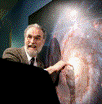Department of Physics and Astronomy: Publications and Other Research

C. Martin Gaskell Publications
Document Type
Article
Date of this Version
9-1-2007
Abstract
We present a Chandra-LETGS observation of the Seyfert 1 galaxy Mrk 279. This observation was carried out simultaneously with HST-STIS and FUSE, in the context of a multi-wavelength study of this source. The Chandra pointings were spread over ten days for a total exposure time of ~360 ks. The maximal continuum flux variation is of the order of 30%. The spectrum of Mrk 279 shows evidence of broad emission features, especially at the wavelength of the OVII triplet. We quantitatively explore the possibility that this emission is produced in the broad line region (BLR). We modeled the broad UV emission lines seen in the FUSE and HST-STIS spectra following the “locally optimally emitting cloud” approach. This method considers the emission from BLR as arising from “clouds” with a wide range of densities and distance from the source. We find that the X-ray lines luminosity derived from the best fit BLR model can match the X-ray features, suggesting that the gas producing the UV lines is sufficient to account also for the X-ray emission. The spectrum is absorbed by ionized gas whose total column density is ~5 × 1020 cm-2. The absorption spectrum can be modeled by two distinct gas components (logξ ~ 0.47 and 2.49, respectively) both showing a significant outflow velocity. However, the data allow also the presence of intermediate ionization components. The distribution of the column densities of such extra components as a function of the ionization parameter is not consistent with a continuous, power law-like, absorber, suggesting a complex structure for the gas outflow for Mrk 279.


Comments
Published in Astronomy & Astrophysics. Copyright EDP Sciences. Used by permission.